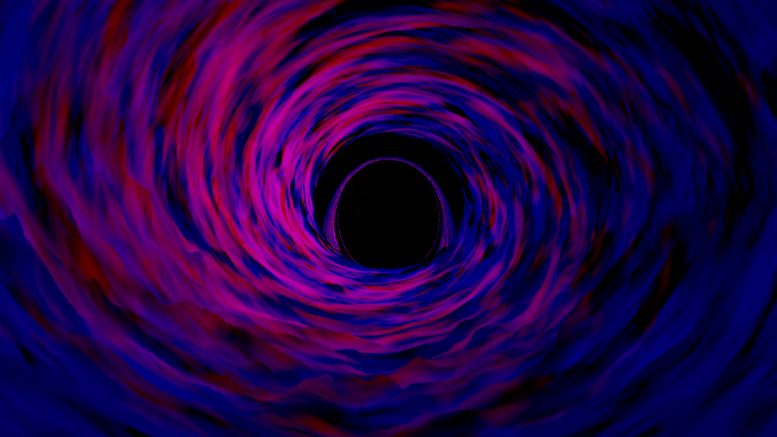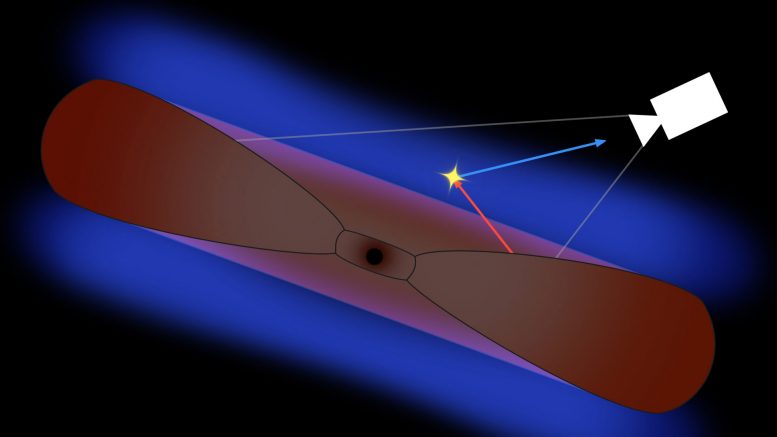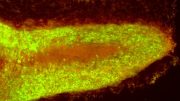
Animations of supercomputer data take you to the inner zone of the accretion disk of a black hole. Credit: NASA’s Goddard Space Flight Center
Astrophysicists re-create and explain nearly all the components seen in the X-ray spectra of stellar-mass black holes.
Black holes may be dark, but the areas around them definitely are not. These dense, spinning behemoths twist up gas and matter just outside their event horizon, and generate heat and energy that gets radiated, in part, as light. When black holes merge, they produce a bright intergalactic burst that may act as a beacon for their collision.
Astrophysicists became deeply interested in black holes in the 1960s, but the idea of their event horizon was first intimated in a paper by Karl Schwarzschild published after Einstein introduced general relativity in 1915.
Knowledge about black holes—these still-unseen objects—has grown tremendously in recent years. Part of this growth comes from researchers’ ability to use detailed numerical models and powerful supercomputers to simulate the complex dynamics near a black hole. This is no trivial matter. Warped spacetime, gas pressure, ionizing radiation, magnetized plasma—the list of phenomena that must be included in an accurate simulation goes on and on.
“It’s not something that you want to do with a paper and pencil,” said Scott Noble, an astrophysicist at the Rochester Institute of Technology (RIT).
This animation of supercomputer data takes you to the inner zone of the accretion disk of a stellar-mass black hole. Gas heated to 20 million degrees F as it spirals toward the black hole glows in low-energy, or soft, X-rays. Just before the gas plunges to the center, its orbital motion is approaching the speed of light. X-rays up to hundreds of times more powerful (“harder”) than those in the disk arise from the corona, a region of tenuous and much hotter gas around the disk. Coronal temperatures reach billions of degrees. The event horizon is the boundary where all trajectories, including those of light, must go inward. Nothing, not even light, can pass outward across the event horizon and escape the black hole. Credit: NASA’s Goddard Space Flight Center/J. Schnittman, J. Krolik (JHU) and S. Noble (RIT). Music: “Lost in Space” by Lars Leonhard, courtesy of the artist.
Working with Jeremy Schnittman of Goddard Space Flight Center and Julian Krolik of Johns Hopkins University, Noble and his colleagues created a new tool that predicts the light that an accreting black hole would produce. They did so by modeling how photons hit gas particles in the disk around the black hole (also known as an accretion disk), generating light—specifically light in the X-ray spectrum—and producing signals detected with today’s most powerful telescopes.
In their June 2013 paper in the Astrophysical Journal, the researchers presented the results of a new global radiation transport code coupled to a relativistic simulation of an accreting, non-rotating black hole. For the first time, they were able to re-create and explain nearly all the components seen in the X-ray spectra of stellar-mass black holes.
The ability to generate realistic light signals from a black hole simulation is a first and brings with it the possibility of explaining a whole host of observations taken with multiple X-ray satellites during the past 40 years.
“We felt excited and also incredibly lucky, like we’d turned up ten heads in a row,” Noble said. “The simulations are very challenging and if you don’t get it just right, it won’t give you an accurate answer. This was the first time that people have put all of the pieces together from first principles in such a thorough way.”
The simulations are the combined results of two computational codes. One, Harm3d, re-creates the three-dimensional dynamics of a black hole accreting gas, including its magnetohydrodynamics (MHD), which charts the interplay of electrically conducting fluids like plasmas and a powerful magnetic field.
“The magnetic field is important in the area outside the black hole because it whips the gas around and can dictate its dynamics,” Noble said. “Also, the movement of the field can lead to it kinking and trigger a reconnection event that produces an explosive burst of energy, turning magnetic field energy into heat.”
Though the MHD forces are critical near the black hole, it is the X-rays these forces generate that can be observed. The second component, a radiative transport code called Pandurata, simulates what real photons do.
“They bounce around inside the gas, they reflect off the disk’s surface, and their wavelengths change along the way,” he explained. “Eventually, they reach some distant light collector—a numerically approximated observer—which provides the predicted light output of our simulation.”
The researchers’ simulations were run on the Ranger supercomputer at the Texas Advanced Computing Center, built with support from the National Science Foundation, which also funded the group’s research.
The simulations were the highest resolution thin disk simulations ever performed, with the most points and the smallest length scales for numerical cells, allowing the researchers to resolve very small features. Varying only the rate at which the black holes accrete gas, they were able to reproduce the wide range of X-ray states seen in observations of most galactic black hole sources.

This illustration shows the approximate relationships between the black hole, its accretion disk and the corona region (blue). The arrows show a soft X-ray (red) traveling into the corona and striking a particle moving near the speed of light. The collision scatters the light and boosts it to much higher energy, making it a hard X-ray. This process is known as inverse Compton scattering. Credit: J. Schnittman, J. Krolik (JHU) and S. Noble (RIT)
With each passing year, the significance of black holes—and their role in shaping the cosmos—grows.
Nearly every good-sized galaxy has a supermassive black hole at its center, said Julian Krolik, a professor of physics and astronomy at Johns Hopkins University. For periods of a few to tens of million years at a time, black holes accrete incredible amounts of gas ultimately released as huge amounts of energy—as much as a hundred times the power output of all the stars in a black hole host galaxy put together.
“Some of that energy can travel out into their surrounding galaxies as ionizing light or fast-moving jets of ionized gas,” Krolik continued. “As a result, so much heat can be deposited in the gas orbiting around in those galaxies that it dramatically alters the way they make new stars. It’s widely thought that processes like this are largely responsible for regulating how many stars big galaxies hold.”
In this way, black holes may act as cosmic regulators—all the more reason to use numerical simulations to uncover further clues about how black holes interact with gas, stars, and other supermassive black holes.
Said Noble: “To see that it works and reproduces the observational data when the observational data is so complicated…it’s really remarkable.”
Reference: “X-Ray Spectra from Magnetohydrodynamic Simulations of Accreting Black Holes” by Jeremy D. Schnittman, Julian H. Krolik and Scott C. Noble, 15 May 2013, The Astrophysical Journal.
DOI: 10.1088/0004-637X/769/2/156
arXiv:1207.2693









Be the first to comment on "Simulations Re-Create the Complex Dynamics Near a Black Hole"